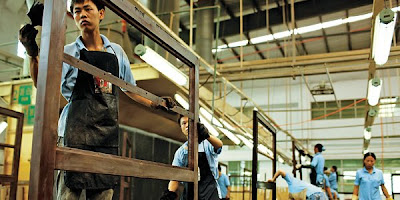 I read an article about the movement of labor force from US to China. It seems like an old story, but just a decade ago, US produced their core products in US. Then, why they had to move to China? First, it's because of the rises in oil prices. If oil price is rising, the shipping costs and also the wage rates will rise. Accordingly, US manufacturers realized that they will bankrupt if they keep producing in US. Now, most of US's labor concentrated industry had moved to China. As a result, the value of US dollar is fall relative to Euro. Also, there are constant threats from rising oil price.
I read an article about the movement of labor force from US to China. It seems like an old story, but just a decade ago, US produced their core products in US. Then, why they had to move to China? First, it's because of the rises in oil prices. If oil price is rising, the shipping costs and also the wage rates will rise. Accordingly, US manufacturers realized that they will bankrupt if they keep producing in US. Now, most of US's labor concentrated industry had moved to China. As a result, the value of US dollar is fall relative to Euro. Also, there are constant threats from rising oil price.Some of US companies now try to make manufactures in US. Because there are fewer producers in US since they moved to China. Accordingly, American citizens' demands are not satisfied. If they can initiate production in US, they can earn considerable profit. But the cost of infrastructure is very high. US manufacturers destroyed their original production base when they moved into China. Then, is China a eternal labor advantage nation? It's not. Because already the productivity of China's workers are rising, also the oil price is rising in a very fast pace. If US manufacturers sustain China, eventually, there businesses will lose their cost advantage. But still China has labor cost advantage about 40~50% compared to the US labor market.
Then, what's the best strategies for the manufacturers who already made huge production base in China? The author suggested that they should continue production in China. Because still China has huge cost advantages. If they are concerned with the future and go out of the industry, their huge investment that is a fixed cost will go away. Yet the costs are not sunk costs. Also, Chinese government keep controlling the rising of labor costs. Accordingly, in the short run, it will be a good choice. But they must find other alternatives. Actually, many of regions remain undeveloped. For example, the Africa and south-east asia regions have great potentials.
If US government will not support their domestic industry, ultimately, their industried will be controlled by China. I think it's the worst situation for US. US has been always a top position of world economy. But now their dollar value are dropped by 50% and their industries are strongly dependent on low cost nations. Additionally, US is a huge consumer of Oil. Accordingly, if oil price is rising, it will more impact on US than China. I think the high efficient and low labor cost products can activate the US's domestic production. If they can invent products like eco-friendly vehicles, cell phones, and home appliances, they can re-emerge their influences to the world. Now, Korean company also move their production base to China. Maybe, Korea's situation has many commons with US. We can analyze our future alternatives through US's solutions.
Author: Pete Engardio
Title: Can the U.S. Bring Jobs Back from China?
Date: June 19, 2008, 5:00PM EST
Page: 2
reference: http://www.businessweek.com/magazine/content/08_26/b4090038429655.htm
entry#15 20700067

















